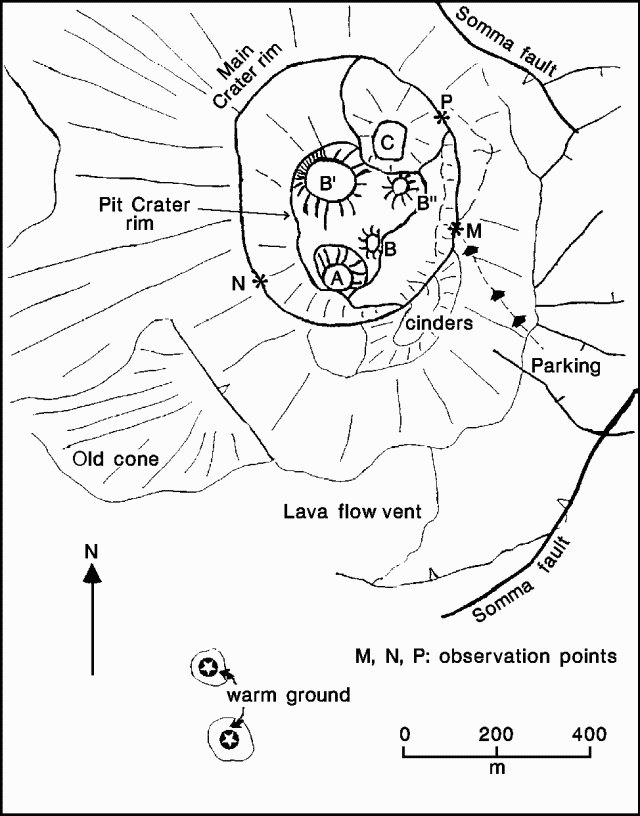Report on Yasur (Vanuatu) — November 1991
Bulletin of the Global Volcanism Network, vol. 16, no. 11 (November 1991)
Managing Editor: Lindsay McClelland.
Yasur (Vanuatu) Strombolian activity and/or small lava lakes at four vents
Please cite this report as:
Global Volcanism Program, 1991. Report on Yasur (Vanuatu) (McClelland, L., ed.). Bulletin of the Global Volcanism Network, 16:11. Smithsonian Institution. https://doi.org/10.5479/si.GVP.BGVN199111-257100
Yasur
Vanuatu
19.532°S, 169.447°E; summit elev. 361 m
All times are local (unless otherwise noted)
The following is from a report by Gérard Granger on activity observed from the summit's main crater rim on 17 and 18 August (LAVE Bulletin, no. 34, Paris, France, p. 2-3).
Active lava lakes and/or Strombolian activity were visible at four vents (A, B, B', and B''; figure 2) within the large pit crater located at the center of the main crater. The fifth summit vent (C), NE of the central pit crater, appeared inactive.
Vent A is located within a deep cylindrical pit, with a 100-m-high nearly vertical S wall. Although the lava surface was not visible, continuous lava fountaining ejected material several meters above the rim. Rare explosions (two on 17 August during 9 hours of observations, and one during 6 hours the next day) threw lava clots 50-80 m above the rim.
Strombolian activity occurred at a small ash cone (vent B), just below the E rim of the central pit crater. Several tens of explosions occurred/hour, occasionally with 7-8 explosions in rapid succession. The narrow eruptive plume rose above the rim of the main summit crater, obscuring the view of vents B' and B'' from the SW rim (point N).
Located within a cinder cone at the NW base of the central pit-crater wall, the 10-m-wide vent B' was the site of the most intense activity. On 17 August, a small, continuously bubbling lava lake was periodically visible within the cone. By the following day, the surface level of the lake had dropped, and it was no longer visible. Approximately one explosion was heard/second, accompanied by ejections of fluid lava. Several (usually ~10) times/hour, a large explosion sent a fountain to 100 m height.
Vent B'' is located within a continuously incandescent crater, 80 m below the top of the NE wall of the central pit crater, where it joins crater C. Loud explosions occurred at a rate of 3 or 4/hour, dropping ballistics onto the pit crater rim. Large quantities of ash were emitted following the explosions.
Geological Summary. Yasur has exhibited essentially continuous Strombolian and Vulcanian activity at least since Captain Cook observed ash eruptions in 1774. This style of activity may have continued for the past 800 years. Located at the SE tip of Tanna Island in Vanuatu, this pyroclastic cone has a nearly circular, 400-m-wide summit crater. The active cone is largely contained within the small Yenkahe caldera, and is the youngest of a group of Holocene volcanic centers constructed over the down-dropped NE flank of the Pleistocene Tukosmeru volcano. The Yenkahe horst is located within the Siwi ring fracture, a 4-km-wide open feature associated with eruption of the andesitic Siwi pyroclastic sequence. Active tectonism along the Yenkahe horst accompanying eruptions has raised Port Resolution harbor more than 20 m during the past century.
Information Contacts: G. Granger, LAVE.


